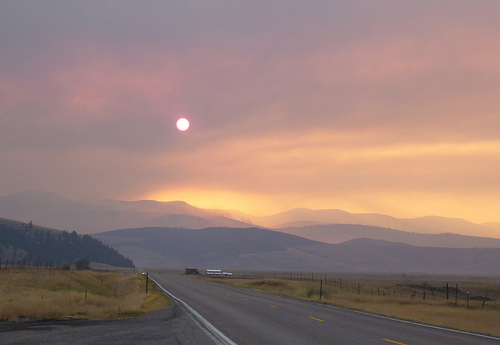Published on
Aligning And Advancing

The following interview is with John Cech, the deputy commissioner for two-year and community college education for the Montana University System and the project director for Montana’s College!NOW Program. Montana is a state in transition, and The Lumina Foundation supported the state with a grant aimed at improving two-year education statewide. In this interview, Cech explains what kinds of changes are happening in the two-year system and how Montana’s higher education system is transforming to meet the state’s evolving needs.
1. College Now is an initiative geared towards making higher education more accessible, better coordinated, better understood and better utilized by Montanans, and it’s supported by the Lumina Foundation. How did the state align with Luminous to launch the project?
… The state has historically had a university focus or a four-year college focus and as a result until about ten years ago, the percentage of our undergraduate enrollment in two-year colleges in Montana was very low. In fact, we were 49th in the nation ten years ago at 17 percent. Now, over the past ten years we’ve actually witnessed a lot of growth and a couple of things have related to that and will tie into our proposal to the Lumina Foundation.
First of all, about seven years ago the Board of Regents… engaged in a strategic planning progress called “The Shared Leadership Initiative,” which involved a wide array of business and industry and agency participation across the state and through the Shared Leadership Initiative, it was identified that Montana … had many needs in higher education, but one in particular that really surfaced was the need to grow its two-year institutions. And so, over the course of the past several years, working with the Board of Regents and working with the Universities across the state, we’ve been doing just that. The former Vo-Techs [vocational technology institutions] … structurally became connected to the universities in the state in 1994. So, in 1994, each of the original five Vo-Techs became connected to one of the universities in the state and at that time their names changed from Vo-Techs to Colleges of Technology. And, beginning with that change, those Colleges of Technology in the mid 90’s were still primarily offering non-transferable programming. Going back to “The Shared Leadership Initiative,” which I had mentioned, we really saw a change, we really saw a push to begin to really make an effort across the five colleges of technology in the state and make them look and respond more like comprehensive two-year colleges, comprehensive community colleges. They’ve been evolving. However, they also have been very, very responsive to the changing workforce needs of the state. …
Another important factor is the fact that Montana’s traditional high school student pipeline is decreasing. … There’s been a lot of effort from the Board of Regents to grow two-year education in Montana. One such action is the fact that they have held tuition constant in the state’s two-year colleges … for six years, which is helping to create more of a gap or more of a difference between the tuition of our two-year colleges and the four-year universities. … Along that same time period, like the rest of the country, we saw economic shifts taking place in Montana, particularly in Western Montana around 2008 with a lot of mill closures and a downturn in the economy, that meant that the two-year colleges, over the last 10 years in Montana… have witnessed dramatic growth. …
So, about two and half years ago, we received an invitation from The Lumina Foundation to submit a proposal. And, basically Lumina’s interested in productivity, they’re interested in state’s desire to increase the number of credentialed citizens. And so Montana submitted a proposal to Lumina basically among several of strategies citing our desire to really grow the two-year colleges in the state and make them better utilized and better understood. We were one of six states funded by The Lumina Foundation for a four year initiative, which we’re about half-way through.
2. Approximately 37.6 percent of Montana’s adult population holds at least a two-year degree and the president’s target is at 60 percent of adults by 2025. Could you elaborate a little bit about how CollegeNow and the Lumina Foundation have set up that adult-friendly focus and how are you getting adults into the classrooms and into the labor market?
Absolutely! We have five strategies which are a part of our CollegeNow initiative and I’ll just take a second and talk about a couple of them.
The first strategy is extending the comprehensive two-year admission to the colleges of technology and the other two-year programs in the state. … So, what we’ve been doing is working with the five colleges of technology to have each of them develop internal plans for extending the comprehensive mission. And, I should note that until last May, the state of Montana did not have a comprehensive mission and vision statement for two-year education and that was something we worked on last year and brought to the Board of Regents in May of 2011 and the board approved it and adopted it. And it’s very simple; it really looks like any comprehensive mission statement you would find in a community college around the country that has five attributes that are centered around:
- University transfer through associate of arts, associate of science degrees;
- Workforce development;
- Being a provider of developmental adult basic education and adult friendly-programming;
- Lifelong Learning;
- Community Development
So, what the Board of Regents subsequently did at their August meeting is they said, “Okay, we’ve created and approved this comprehensive two-year education mission statement,” it actually was developed locally by each of the two-year colleges, they all worked together on it. The board then approved a 25-month timeline for extending that to the five colleges of technology. … The Board of Regents expanded that to also include two-year programs that are offered and partnership of the universities. … So, we’re really looking at nine units where we’re looking to extend this comprehensive mission to them, make them look at, feel and respond more like comprehensive community colleges, comprehensive two-year colleges. …
We’re significantly increasing access to the comprehensive two-year mission in the state. And, a big piece of that involves doing a much better job statewide in reaching out to the adult learner, particularly the learner who is 25 and older. So, we will be working with each of the campuses and through their planning process to learn from our existing programs and experiences in students how we can better serve the adult learner. And through The Lumina Foundation, we have the funds to conduct … an “AFLI” (Adult-Friendly Learner Inventory) assessment at each of the 12 campuses that provide two-year education in the state. …
We’ll also receive a system-level report so we can take a look at it from the prospective of the 12 campuses of the state. And then we’ll also be able to benchmark against CAEL’s work in doing this across the country. This data will be very helpful in helping each of the campuses, in their strategic planning efforts, to really think through how they’re serving the non-traditional learner currently and how they can improve it for the future.
3. Are there any major turnovers or major changes coming just based on your experience, especially having worked as the dean of continuing education at Rocky Mountain College for many years prior to this position. What are some of the changes you think are going to be most important to system?
Higher education nationally … has been operating pretty much as it has for the last 150 years. In an agrarian model, where the students return in the fall, and then they’re out for the summer in early May. And that they primarily are working in a going to school at 7 a.m. until 3-4 in the afternoon. … Most institutions of higher education are still set up that way with respect to the core. And obviously there’s some great models out there, some very innovative institutions which are really busting a paradigm, but I think if you really take a look at universities, and even community colleges, … that’s the core of what they do and society is changing, demands are changing, learning styles are changing and I think it’s going to be really important for our educational institutions to change with it.
Now, that doesn’t mean you throw the baby out with the bath water … because you’re still going to probably have a core of students who like that model; the traditional model. But I think, we’re going to see an increasing number, and we already are seeing an increasing number, of students both traditional and non-traditionally aged who are looking for more flexibility and I think getting into it we’re still based on a Carnegie unit model and I think over the next several years, we’re going to be seeing more and more of a push towards learning outcomes assessment versus the Carnegie classroom unit.
4. On the idea of the learning outcomes assessments, what goes into finding out what is effective and what isn’t, and how would those changes come about? What is the timeline for changes in that matter?
Here in Montana, we’re working on that. We’re starting at the developmental education, remedial education. We have some pilots going on right where we’re turning our developmental education classes really on their side and remaking them using a couple of our campuses who … [using] analytics to assess the incoming student’s challenges, say in mathematics; “Where are they weak?” And once you’ve identified that instead of forcing students to sit through a semester-long remedial course, they really work in a non-traditional environment with computer-based instruction, … learning facilitator to help them bridge that gap and then take a post-test that determines if they are ready to go into college-level math and the goal there is to get the student into college-level courses as soon as possible, which there’s a lot of data out there that shows that students who get into college-level courses faster, have a much higher chance of persistence, so we’re working on that. We’re actually exploring some external funding opportunities to move that initiative across the state with each of our two-year colleges which offer developmental education and remedial education. …
So, we’re really starting to create more of a focus on outcomes so that we can look at these classes based on outcomes. So, it’s a process, it’s a start, we’re definitely making great progress. We still have a ways to go as well.
5. The unemployment rate for Montana sits at 7.1 percent right now which is 1.4 percent lower than the national average. How does the states in your institutions align their offerings with businesses and industries to meet today’s workforce needs, to create that pathway all the way from the education system into employment?
And that’s a great question and I’d like to take a second and just describe Montana for you. … You have Western Montana, which is the mountainous, forested region, which has historically been an economy based on areas of things like healthcare, service, timber, some mining and lots of lots of … second homes. People from all over the country building second homes in Western Montana. And then Eastern Montana is home of some island mountain ranges but really rugged plains and underneath Eastern Montana you have some of the largest coal deposits in the lower 48 of the United States, and in Eastern Montana you also have a portion of the deposit [of the] Bakken oil reserve which stretches from Montana into the Dakotas and there’s some thought that the Bakken reserve and then underneath it is Three Forks oil reserve could be as large as the oil reserves in Saudi Arabia. So, we really have a tale of two Montanas. In that eastern third of Montana right now, unemployment is somewhere between 2.5-3 percent, depending on which county you’re in. It’s virtually full employment. In Western Montana, the Northwest Montana … has the unemployment right now close to 14 percent. …
And so, we’re looking at the prospect of economic development, energy development in Eastern Montana of great significance. And so, what our two-year colleges are doing … and they do a very good job at this, is they are networking with local and regional businesses and industries to make sure that they’re at the forefront of understanding what needs exist in those counties. …
There’s a lot of work going on there. … The Board of Regents in the November meetings put together a workforce development taskforce. … And so, we’ve put together a significant taskforce, significant membership comprised of people from all around the state. And, we’re going to Sydney, Montana — in the epicenter of this energy development — and we’ll be holding a series of meetings … to better align and better connect how higher education — not only the two year colleges but also the four-year colleges and universities — can be a part of this economic development and the solution because it’s become very clear that this particular energy boom is not going to go away.
It’s probably going to impacting this region for the next 20-30 years so they’re going to need more than simply short-time safety training and trauma training or ocean training. They are going to need master’s prepared engineers and teachers and technicians and it’s going to go on and on and on. And there’s also the infrastructure impact from all this growth. So it’s sort of an interesting situation Montana’s in, given the fact that the rest of the United States is still struggling to come out of the recession.
Author Perspective: Administrator
Author Perspective: Community College



